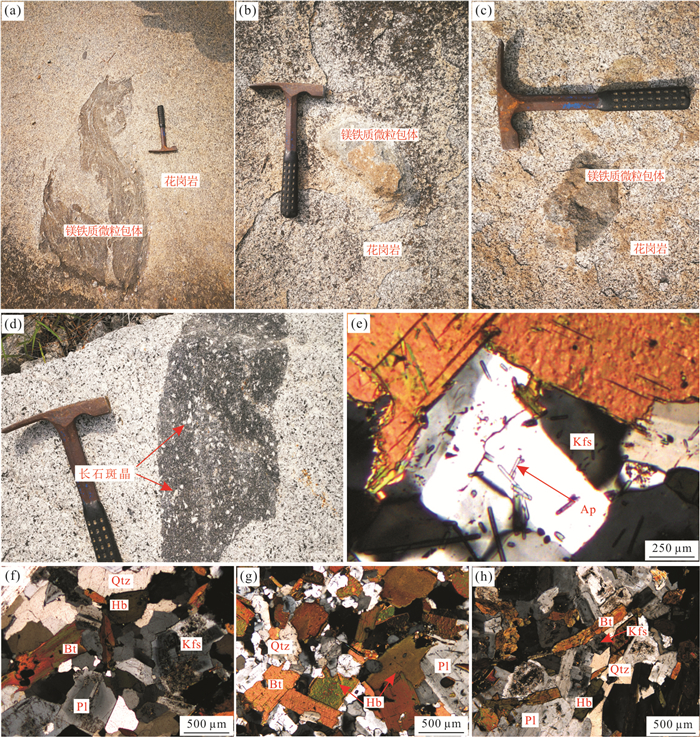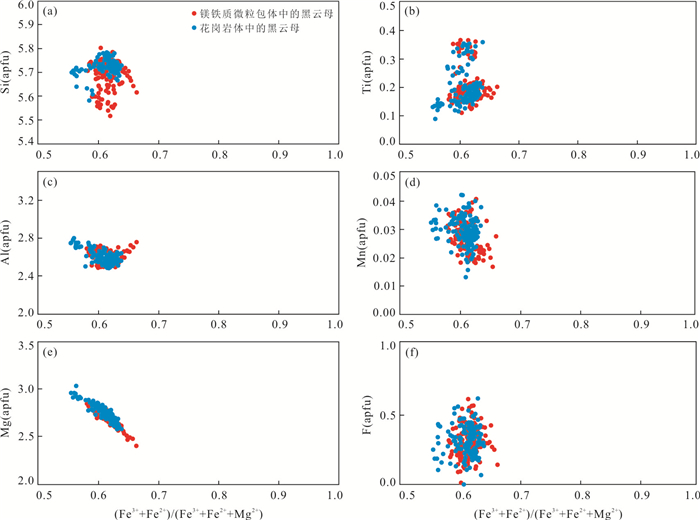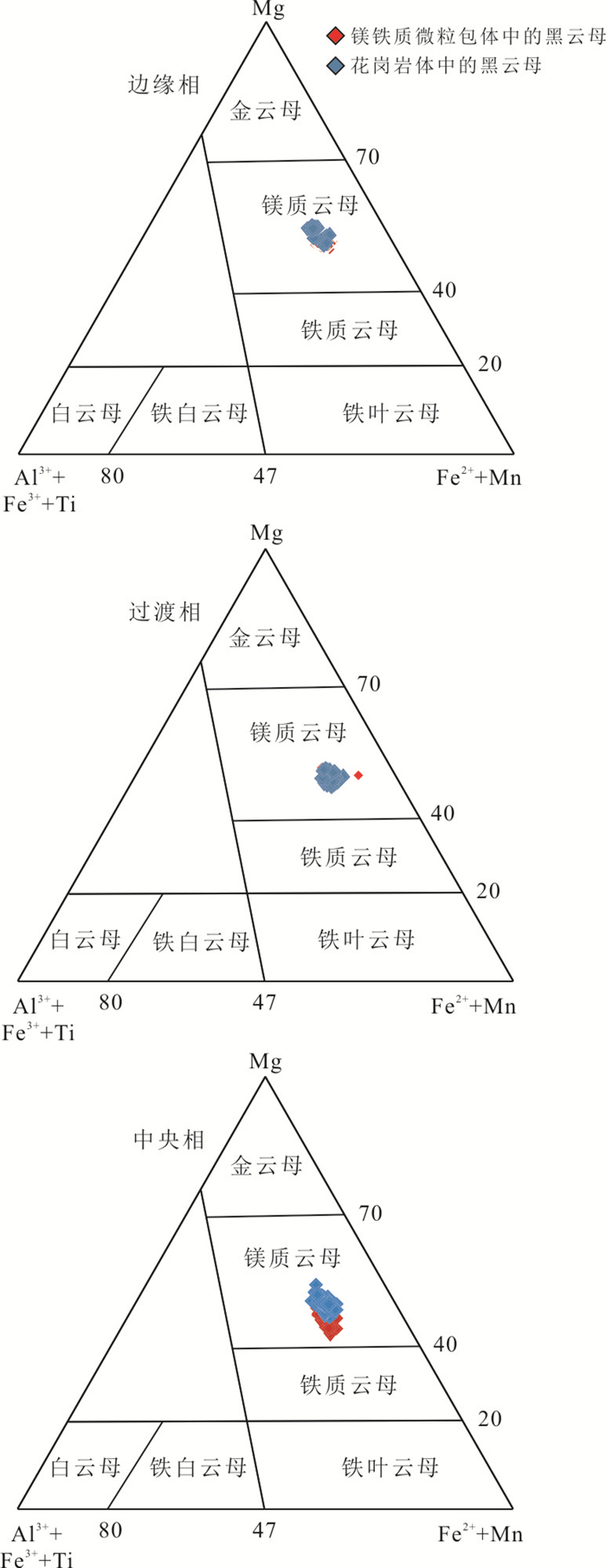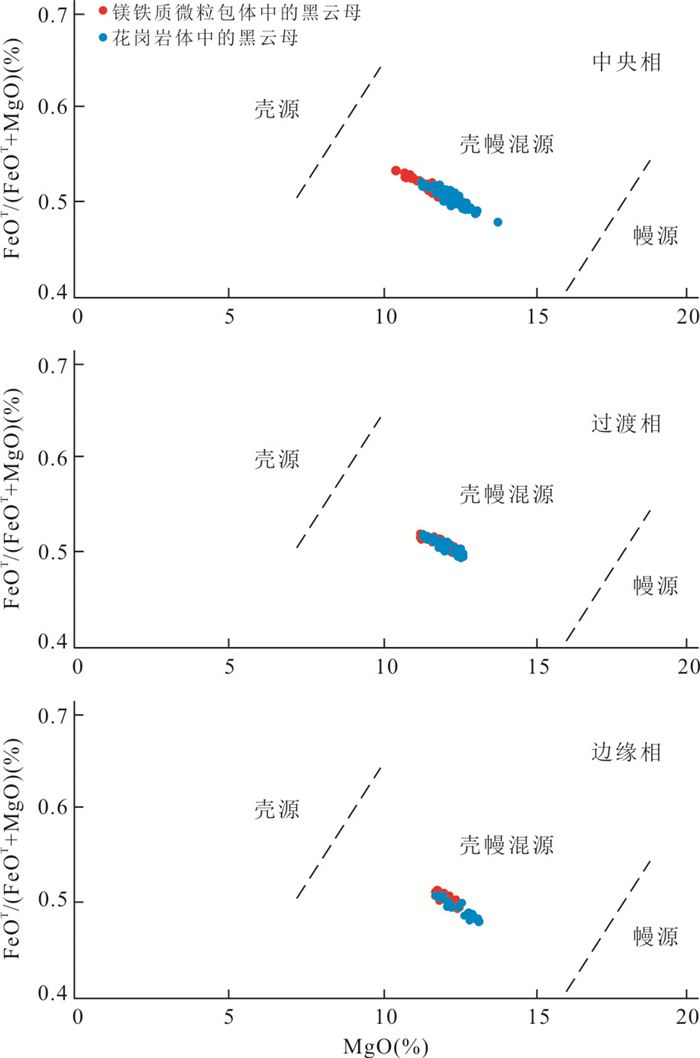Mineral Chemistry of Biotite and Its Petrogenesis Implications in Fangshan Granite, Beijing
-
摘要: 房山岩体位于华北克拉通燕山构造带内,在平面上为不对称环状分布的复式侵入体.其主要由多期侵入的花岗闪长质岩石组成,被划分为中央相、过渡相和边缘相3个岩相带,岩体内部分布大量的暗色镁铁质微粒包体.黑云母作为中酸性火成岩中重要的镁铁质矿物,其矿物化学特征可以记录岩浆属性以及岩石形成时的物理化学条件.本研究对房山花岗岩体和暗色镁铁质微粒包体中的黑云母进行了系统的岩相学观察,并通过电子探针分析对黑云母的化学组成进行了详细研究,从而探讨房山花岗岩体的岩浆来源以及岩浆混合作用过程.结果表明,花岗岩体和暗色镁铁质微粒包体中的黑云母具有相似的矿物化学成分.花岗岩体中的黑云母富Mg,贫Fe,属于镁质黑云母.从外向内3个相带的花岗岩中黑云母的含铁系数[(Fe3++Fe2+)/(Fe3++Fe2++Mg2+)]分别为0.42~0.47,0.45~0.47,0.41~0.46.FeOT/MgO均接近0.60.MF值[2×Mg/(Fe2++Mg+Mn)]分别为1.05~1.21,1.06~1.15,1.12~1.23,指示3个相带的花岗岩的物质来源均发生了壳幔混染.从外向内3个相带中的暗色镁铁质微粒包体中的黑云母富Mg,贫Fe,属于镁质黑云母,含铁系数[(Fe3++Fe2+)/(Fe3++Fe2++Mg2+)]分别为0.44~0.48,0.45~0.50,0.44~0.52.FeOT/MgO均接近0.60.MF值[2×Mg/(Fe2++Mg+Mn)]分别为1.00~1.16,1.03~1.15,1.10~1.18,说明包体的岩浆受到了中酸性岩浆的影响,发生了岩浆混合.花岗岩体与暗色镁铁质微粒包体中的黑云母矿物化学特征相似,但不同岩相带之间存在差异,推测该区域发生了一个多阶段的岩浆相互作用过程,可能为幔源基性岩浆注入壳源酸性岩浆,在岩浆房内以不同程度进行了岩浆混合.Abstract: The Fangshan granite is located in the Yanshan tectonic belt of the North China craton, and is an asymmetric annular intrusive body. It is mainly composed of multi-stage intrusive granodiorites which are divided into three lithofacies belts including central facies, transitional facies and marginal facies. In addition, there are a lot of mafic microgranular enclaves (MMEs) distributed within the pluton. Biotite is one of the main minerals in intermediate acid igneous rocks, and its mineral geochemical characteristics record the properties of host magma and the physical and chemical conditions of petrogenesis. In this study, the biotite in the granite and MMEs was systematically observed. The chemical composition of biotite was studied in detail by electron probe microanalysis (EPMA). Finally, the magma source and mixing process of the Fangshan granite are discussed. The results show that the biotite in the granite and the MMEs have similar chemical compositions. The biotite in the granite is rich in Mg and poor in Fe, which belongs to magnesian biotite. The iron content coefficients[(Fe3++Fe2+)/(Fe3++Fe2++Mg2+)] of granite in three facies zones from the outside to the inside are 0.42-0.47, 0.45-0.47 and 0.41-0.46, respectively. The FeOT/MgO ratio is close to 0.60. The MF values[2×Mg/(Fe2++Mg+Mn)] are 1.05-1.21, 1.06-1.15 and 1.12-1.23, indicating the source material were derived from crust-mantle mixed rocks. The biotite's MF values of MMEs in three lithofacies belts from the outside to the inside are 1.00-1.16, 1.03-1.15 and 1.10-1.18. The biotite is magnesia biotite, suggesting that primitive magma was influenced by intermediate-acid magma. The above results show that biotite from both the granite and MMEs has similar chemical characteristics. However, there are some differences among different lithofacies. Therefore, it speculates that magma mixing has occurred in the Fangshan granite. The magma mixing is a multi-stage interaction process and may be caused by the mantle-derived magma which is injected into the crustal-derived acid magma during multiple stages.
-
Key words:
- biotite /
- mineral chemistry /
- magma mixing /
- Fangshan granite /
- North China craton /
- tectonics
-
图 4 花岗岩及镁铁质微粒包体中黑云母分类图
Fig. 4. Classification diagrams for biotite in granite and mafic microgranular enclaves
图 5 花岗岩及镁铁质微粒包体中黑云母的FeOT/(FeOT+MgO)-MgO图解
Fig. 5. FeOT/(FeOT + MgO)-MgO diagrams of biotite in granite and mafic microgranular enclaves
图 6 铁质微粒包体中黑云母构造环境判别图
据Abdel-Rahman(1994);A-A型花岗岩;C-I型花岗岩;P-S型花岗岩
Fig. 6. Discrimination diagrams of tectonic setting for biotite in mafic microgranular enclaves
表 1 房山花岗岩及包体中黑云母的化学组成(%)
Table 1. Biotite chemical composition of the Fangshan granite and MMEs (%)
岩性 边缘相(中粒花岗闪长岩)
39°42′26″N,
115°56′38″E
19FS3-1,
19FS3-3
n=19过渡相(似斑状花岗闪长岩)
39°42′40″N,
115°56′34″E
19FS2-1,
19FS2-2, 19FS2-3
n=66中央相(斑状花岗闪长岩)
39°43′28″N,
115°56′8″E
19FS1-1,
19FS1-3
n=64边缘相包体
39°42′40″N,
115°56′34″E
19FS3-1,
19FS3-3
n=41过渡相包体
39°43′32″N,
115°56′23″ E
19FS2-1,
19FS2-2, 19FS2-3
n=64中央相包体
39°43′28″N,
115°56′8″E
19FS1-1,
19FS1-3
n=62GPS 样品编号 测试点数量 最小值 最大值 平均值 最小值 最大值 平均值 最小值 最大值 平均值 最小值 最大值 平均值 最小值 最大值 平均值 最小值 最大值 平均值 SiO2 36.91 38.06 37.57 36.89 38.20 37.49 35.56 38.19 37.04 37.32 38.26 37.71 36.30 37.99 37.27 35.88 38.34 36.94 TiO2 0.78 1.79 1.33 1.01 1.87 1.43 1.34 3.07 2.09 1.25 1.79 1.54 1.51 2.00 1.74 0.97 3.17 2.20 Al2O3 14.58 15.75 15.17 13.79 14.86 14.24 13.71 15.23 14.21 14.41 15.31 14.83 13.72 14.45 14.14 13.78 15.14 14.37 FeO 16.27 18.58 17.30 18.13 19.96 19.26 17.25 20.14 18.92 17.38 19.39 18.32 18.27 19.97 19.27 18.02 20.51 19.08 MnO 0.21 0.32 0.25 0.12 0.32 0.22 0.10 0.31 0.22 0.20 0.29 0.24 0.15 0.31 0.21 0.13 0.30 0.20 MgO 11.98 13.35 12.77 11.43 12.71 12.07 11.24 13.52 12.07 11.93 12.69 12.31 11.30 12.41 11.94 10.49 12.69 11.79 CaO 0.00 0.04 0.01 0.00 0.06 0.01 0.00 0.06 0.02 0.00 0.05 0.01 0.00 0.24 0.01 0.00 0.12 0.01 Na2O 0.03 0.11 0.06 0.01 0.10 0.06 0.01 0.11 0.06 0.03 0.10 0.06 0.00 0.75 0.06 0.03 0.17 0.07 K2O 9.96 10.46 10.28 9.73 10.47 10.14 9.66 10.47 10.11 9.76 10.53 10.22 9.83 10.73 10.22 9.70 10.52 10.17 F 0.00 0.93 0.50 0.14 1.29 0.62 0.22 1.17 0.73 0.02 0.84 0.46 0.27 1.18 0.70 0.20 1.29 0.72 Total 94.30 95.52 95.03 94.60 96.68 95.28 94.61 95.87 95.16 94.62 96.26 95.51 93.88 96.36 95.28 94.50 96.29 95.25 Si 5.65 5.73 5.70 5.67 5.79 5.73 5.51 5.78 5.67 5.65 5.75 5.71 5.65 5.76 5.71 5.52 5.80 5.65 Ti 0.09 0.21 0.15 0.11 0.22 0.16 0.15 0.36 0.24 0.14 0.20 0.18 0.17 0.23 0.20 0.11 0.37 0.25 Al 2.62 2.80 2.71 2.48 2.68 2.56 2.48 2.72 2.56 2.58 2.72 2.65 2.48 2.63 2.55 2.49 2.76 2.59 Fe3+ 0.20 0.27 0.25 0.18 0.30 0.25 0.21 0.32 0.26 0.22 0.29 0.26 (0.05) 0.28 0.24 0.22 0.29 0.26 Fe2+ 1.79 2.12 1.95 2.06 2.39 2.22 1.95 2.36 2.17 1.94 2.18 2.06 2.06 2.56 2.23 2.01 2.42 2.18 Mn 0.03 0.04 0.03 0.02 0.04 0.03 0.01 0.04 0.03 0.02 0.04 0.03 0.02 0.04 0.03 0.02 0.04 0.03 Mg 2.73 2.99 2.89 2.60 2.88 2.75 2.59 3.06 2.75 2.70 2.87 2.78 2.61 2.82 2.73 2.42 2.87 2.69 Ca 0.00 0.01 0.00 0.00 0.01 0.00 0.00 0.01 0.00 0.00 0.01 0.00 0.00 0.04 0.00 0.00 0.02 0.00 Na 0.01 0.03 0.02 0.00 0.03 0.02 0.00 0.03 0.02 0.01 0.03 0.02 0.00 0.23 0.02 0.01 0.05 0.02 K 1.94 2.03 1.99 1.89 2.04 1.98 1.88 2.04 1.97 1.90 2.03 1.97 1.93 2.13 2.00 1.90 2.05 1.99 Al (IV) 2.27 2.35 2.30 2.21 2.33 2.27 2.22 2.49 2.33 2.25 2.35 2.29 2.24 2.35 2.29 2.20 2.48 2.35 FeOT/(FeOT + MgO) 0.56 0.61 0.58 0.59 0.64 0.62 0.56 0.64 0.61 0.58 0.62 0.60 0.60 0.64 0.62 0.59 0.66 0.62 MF 1.12 1.23 1.19 1.06 1.15 1.10 1.05 1.21 1.11 1.10 1.18 1.14 1.03 1.15 1.10 1.00 1.16 1.10 含铁系数 0.41 0.46 0.43 0.45 0.49 0.47 0.42 0.50 0.47 0.44 0.48 0.46 0.45 0.50 0.48 0.44 0.52 0.48 -
Abdel-Rahman, A. F. M., 1994. Nature of Biotites from Alkaline, Calc-Alkaline, and Peraluminous Magmas. Journal of Petrology, 35(2): 525-541. https://doi.org/10.1093/petrology/35.2.525 Bai, J., Dai, F.Y., 1996. The Early Precambrian Crustal Evolution of China. Journal of Southeast Asian Earth Sciences, 13: 205-214. doi: 10.1016/0743-9547(96)00027-X Barbarin, B., 2005. Mafic Magmatic Enclaves and Mafic Rocks Associated with Some Granitoids of the Central Sierra Nevada Batholith, California: Nature, Origin, and Relations with the Hosts. Lithos, 80 (1-4): 155-177. doi: 10.1016/j.lithos.2004.05.010 Burkhard, D.J.M., 1991. Temperature and Redox Path of Biotite-Bearing Intrusives: A Method of Estimation Applied to S- and I-Type Granites from Australia. Earth and Planetary Science Letters, 104(1): 89-98. doi: 10.1016/0012-821X(91)90240-I Cai, J.H., Yan, G.H., Mu, B.L., et al., 2005. Zircon U-Pb Age, Sr-Nd-Pb Isotopic Compositions and Trace Element of Fangshan Complex in Beijing and Their Petrogenesis Significance. Acta Petrologica Sinica, 21(3): 776-788 (in Chinese with English abstract). Chen, B., Xiong, F. H., Ma, C. Q., et al., 2021. Coupling Relationship between Magmatic Mixing and Igneous Diversity: A Case Study of the Baiqili Felsic Pluton in East Kunlun Orogenic Belt. Earth Science, 46(6): 2057-2072 (in Chinese with English abstract). Chen, N.S., Chen, B.H., Roger, M., et al., 2018. Preliminary Identification of Magmatic Emplacement Mechanism of Fangshan Pluton in Beijing Using Contact Metamorphism Markers. Earth Science, 43(1): 99-108 (in Chinese with English abstract). El Sheshtawi, Y.A., Salem, A.K.A., Aly, M.M., 1993. The Geochemistry of Ferrous Biotite and Petrogenesis of Wadi-El-Sheikh Granitoid Rocks Southwestern Sinai, Egypt. Journal of African Earth Sciences (and the Middle East), 16(4): 489-498. doi: 10.1016/0899-5362(93)90106-Z Foster, M.D., 1960. Interpretation of the Composition of Trioctahedral Micas. Geological Survey Professional Paper, 354(B): 1-49. http://pubs.usgs.gov/pp/0354b/report.pdf Gao, P., Zhao, Z. F., Zheng, Y. F., 2016. Magma Mixing in Granite Petrogenesis: Insights from Biotite Inclusions in Quartz and Feldspar of Mesozoic Granites from South China. Journal of Asian Earth Sciences, 123: 142-161. doi: 10.1016/j.jseaes.2016.04.003 Hbbard, M.J., 1981. The Magma Mixing Origin of Mantled Feldspars. Contributions to Mineralogy and Petrology, 76: 158-170. doi: 10.1007/BF00371956 Jean, D., 1987. Contribution of Enclave Studies to the Understanding of Origin and Evolution of Granitic Magmas. Geologische Rundschau, 76(1): 41-50. https://doi.org/10.1007/BF01820572 Jiang, S.Y., Zhao, K.D., Jiang, Y.H., et al., 2006. New Type of Tin Mineralization Related to Granite in South China: Evidence from Mineral Chemistry, Element and Isotope Geochemistry. Acta Petrologica Sinica, 22(10): 2509-2516 (in Chinese with English abstract). Kusky, T.M., Li, J.H., 2003. Paleoproterozoic Tectonic Evolution of the North China Craton. Journal of Asian Earth Sciences, 22: 23-40. Li, X., Wang, L.Z., Tu, B., et al., 2021. Zircon Geochronology, Geochemistry and Petrogenesis of the Taibao Pluton in Northwest Guangdong Province. Earth Science, 46(4): 1199-1216 (in Chinese with English abstract). Lü, Z.C., Duan, G.Z., Dong, G.H., 2003. Mineral Chemistry of Biotite from Granites Associated with Different Mineralization in Three Stages of Yanshanina Period in the Southern-Middle Parts of the Da Hinggan Ling Mountains and Its Petrogenetic and Metallogenic Significance. Acta Mineralogica Sinica, 23(2): 177-184 (in Chinese with English abstract). http://en.cnki.com.cn/Article_en/CJFDTOTAL-KWXB200302014.htm Ma, C.Q., Wang, R.J., Qui, J.X., 1992. Enclaves as Indicators of the Origin of Granitoid Magma and Repeater Magma Mingling: An Example from the Zhoukoudian Intrusion, Beijing. Geological Review, 38(2): 109-119 (in Chinese with English abstract). http://search.cnki.net/down/default.aspx?filename=DZLP199202001&dbcode=CJFD&year=1992&dflag=pdfdown Ning, W.B., Wang, J.P., Xiao, D., et al., 2019. Electron Probe Microanalysis of Monazite and Its Applications to U-Th-Pb Dating of Geological Samples. Journal of Earth Science, 30(5): 952-963. doi: 10.1007/s12583-019-1020-8 Pignatelli, I., Faure, F., Mosser-Ruck, R., 2016. Self-Mixing Magma in the Ruiz Peak Rhyodacite, New Mexico, USA: A Mechanism Explaining the Formation of Long Period Polytypes of Mica. Lithos, 266-267: 332-347. doi: 10.1016/j.lithos.2016.10.024 Qin, F., Xu, X.X., Luo, Z.H., 2006. Evidence of Magmatic Mixing during the Formation of Fangshan Pluton, Beijing. Acta Petrologica Sinica, 28(2): 2957-2970 (in Chinese with English abstract). Słaby, E., Martin, H., 2008. Mafic and Felsic Magma Interaction in Granites: The Hercynian Karkonosze Pluton (Sudetes, Bohemian Massif). Journal of Petrology, 49(2): 353-391. https://doi.org/10.1093/petrology/egm085 Sun, J., Yang, J., Wu, F., et al., 2010. Magma Mixing Controlling the Origin of the Early Cretaceous Fangshan Granitic Pluton, North China Craton: In Situ U-Pb Age and Sr-, Nd-, Hf- and O-Isotope Evidence. Lithos, 120: 421-438. doi: 10.1016/j.lithos.2010.09.002 Tao, J.D., Ma, C.Q., Zhang, J.Y., et al., 2009. Evolution of Enclaves in Beijing Fangshan Granodiorite and Genesis of Dioritic Microgranular Enclaves. Geological Science and Technology Information, 28(2): 33-41 (in Chinese with English abstract). http://en.cnki.com.cn/Article_en/CJFDTOTAL-DZKQ200902006.htm Temizel, İ., Arslan, M., Abdioğlu, E., et al., 2014. Mineral Chemistry and Thermobarometry of Eocene Monzogabbroic Stocks from the Bafra (Samsun) Area in Turkey: Implications for Disequilibrium Crystallization and Emplacement Conditions. International Geology Review, 56(10): 1226-1245. https://doi.org/10.1080/00206814.2014.933363 Wang, D.Z., Xie, L., 2008. Magma Mingling: Evidence from Enclaves. Geological Journal of China Universities, 14(1): 16-21 (in Chinese with English abstract). Wang, J., Li, X., Ning, W., et al., 2019. Geology of a Neoarchean Suture: Evidence from the Zunhua Ophiolitic Mélange of the Eastern Hebei Province, North China Craton. GSA Bulletin, 131(11/12): 1943-1964. http://www.researchgate.net/publication/332639169_Geology_of_a_Neoarchean_suture_Evidence_from_the_Zunhua_ophiolitic_melange_of_the_Eastern_Hebei_Province_North_China_Craton Wang, X.L., 2017. Some New Research Progresses and Main Scientific Problems of Granitic Rocks. Acta Petrologica Sinica, 33(5): 1445-1458 (in Chinese with English abstract). http://en.cnki.com.cn/Article_en/CJFDTOTAL-YSXB201705005.htm Weidendorfer, D., Mattsson, H. B., Ulmer, P., 2014. Dynamics of Magma Mixing in Partially Crystallized Magma Chambers: Textural and Petrological Constraints from the Basal Complex of the Austurhorn Intrusion (SE Iceland). Journal of Petrology, 55(9): 1865-1903. https://doi.org/10.1093/petrology/egu044 Xie, Y. W., Zhang, Y. Q., 1987. Typomorphic Characteristics of Biotite in Granitoids of Different Genetic Types in Hengduan Mountains. Acta Mineralogica Sinica, 7(3): 245-254 (in Chinese with English abstract). http://en.cnki.com.cn/Article_en/CJFDTOTAL-KWXB198703006.htm Xu, B., Jiang, S.Y., Wang, R., et al., 2015. Late Cretaceous Granites from the Giant Dulong Sn-Polymetallic Ore District in Yunnan Province, South China: Geochronology Geochemistry, Mineral Chemistry and Nd-Hf Isotopic Compositions. Lithos, 218-219: 54-72. doi: 10.1016/j.lithos.2015.01.004 Xu, H.J., Song, Y.R., Zhang, J.F., et al., 2012. Geological Field Practice Teaching of Magma Mixing in the Fangshan Pluton in Zhoukoudian District of Beijing. Chinese Geological Education, 21(4): 135-139 (in Chinese with English abstract). http://en.cnki.com.cn/Article_en/CJFDTotal-JYDZ201204038.htm Yan, G. H., Xu, B. L., Mou, B. L., et al., 1995. REE Geochemistry of Diorite Inclusions in the Fangshan Pluton and Their Genesis. Science in China (Series B: Chemistry), 25(2): 219-224 (in Chinese). Zhang, Q., Pan, G.Q., Li, C.D., et al., 2007. Granitic Magma Mixing versus Basaltic Magma Mixing: New Viewpoints on Granitic Magma Mixing Process: Some Crucial Questions on Granite Study (1). Acta Petrologica Sinica, 23(5): 1141-1152 (in Chinese with English abstract). http://www.en.cnki.com.cn/Article_en/CJFDTOTAL-YSXB200705027.htm Zhao, K. D., Jiang, S. Y., Zhu, J. C., et al., 2010. Hf Isotopic Composition of Zircons from the Huashan-Guposhan Intrusive Complex and Their Mafic Enclaves in Northeastern Guangxi: Implication for Petrogenesis. Chinese Science Bulletin, 55(6): 509-519. https://doi.org/10.1007/s11434-009-0314-0 Zhao, M., Yang, S.Y., Zuo, R.G., et al., 2015. Magmatic Evolution Characteristics of Xiangshan Volcanic-Intrusive Complex from the Gan-Hang Belt: Studies on the Mineral Chemistry of Plagioclase and Biotite. Acta Petrologica Sinica, 31(3): 759-768 (in Chinese with English abstract). http://en.cnki.com.cn/Article_en/CJFDTOTAL-YSXB201503010.htm Zhou, Z.G., Luo, Z.H., He, M.Y., 1992. Preliminary Discussion on Mapping Units of Fangshan Rock Mass in Beijing. Regional Geology of China, (2): 156-160 (in Chinese with English abstract). Zhou, Z.X., 1988. Chemical Composition of Mafic Mica in Intrusive Rocks and Their Geological Significance. Acta Petrologica Sinica, 4(3): 63-73 (in Chinese with English abstract). http://www.researchgate.net/publication/285511829_Chemical_characteristics_of_mafic_mica_in_intrusive_rocks_and_its_geological_meaning 蔡剑辉, 阎国翰, 牟保磊, 等, 2005. 北京房山岩体锆石U-Pb年龄和Sr、Nd、Pb同位素与微量元素特征及成因探讨. 岩石学报, 21(3): 776-788. https://www.cnki.com.cn/Article/CJFDTOTAL-YSXB200503018.htm 陈兵, 熊富浩, 马昌前, 等, 2021. 岩浆混合作用与火成岩多样性的耦合关系: 以东昆仑造山带白日其利长英质岩体为例. 地球科学, 46(6): 2057-2072. doi: 10.3799/dqkx.2020.241 陈能松, 陈冰寒, Roger, M., 等, 2018. 用接触变质作用标志初步判别北京房山岩体的岩浆侵位机制. 地球科学, 43(1): 99-108. doi: 10.3799/dqkx.2018.006 蒋少涌, 赵葵东, 姜耀辉, 等, 2006. 华南与花岗岩有关的一种新类型的锡成矿作用: 矿物化学、元素和同位素地球化学证据. 岩石学报, 22(10): 2509-2516. https://www.cnki.com.cn/Article/CJFDTOTAL-YSXB200610010.htm 李响, 王令占, 涂兵, 等, 2021. 粤西北印支期太保岩体的锆石U-Pb年代学、地球化学及岩石成因. 地球科学, 46(4): 1199-1216. doi: 10.3799/dqkx.2020.193 吕志成, 段国正, 董广华, 2003. 大兴安岭中南段燕山期三类不同成矿花岗岩中黑云母的化学成分特征及其成岩成矿意义. 矿物学报, 23(2): 177-184. doi: 10.3321/j.issn:1000-4734.2003.02.015 马昌前, 王人镜, 邱家骧, 1992. 花岗质岩浆起源和多次岩浆混合的标志: 包体: 以北京周口店岩体为例. 地质论评, 38(2): 109-119. doi: 10.3321/j.issn:0371-5736.1992.02.002 覃锋, 徐晓霞, 罗照华, 2006. 北京房山岩体形成过程中的岩浆混合作用证据. 岩石学报, 28(2): 2957-2970. https://www.cnki.com.cn/Article/CJFDTOTAL-YSXB200612012.htm 陶继东, 马昌前, 张金阳, 等, 2009. 北京房山花岗闪长岩体中包体的演化及闪长质微粒包体的成因. 地质科技情报, 28(2): 33-41. doi: 10.3969/j.issn.1000-7849.2009.02.007 王德滋, 谢磊, 2008. 岩浆混合作用: 来自岩石包体的证据. 高校地质学报, 14(1): 16-21. doi: 10.3969/j.issn.1006-7493.2008.01.002 王孝磊, 2017. 花岗岩研究的若干新进展与主要科学问题. 岩石学报, 33(5): 1445-1458. https://www.cnki.com.cn/Article/CJFDTOTAL-YSXB201705005.htm 谢应雯, 张玉泉, 1987. 横断山不同成因类型花岗岩类岩石中黑云母的标型特征. 矿物学报, 7(3): 245-254. doi: 10.3321/j.issn:1000-4734.1987.03.007 续海金, 宋衍茹, 章军锋, 等, 2012. 北京周口店地区房山岩体中岩浆混合作用的野外实践教学. 中国地质教育, 21(4): 135-139. doi: 10.3969/j.issn.1006-9372.2012.04.040 阎国翰, 许保良, 牟保磊, 等, 1995. 房山岩体中闪长岩质包体的矿物稀土元素地球化学及其包体成因. 中国科学(B辑: 化学), 25(2): 219-224. https://www.cnki.com.cn/Article/CJFDTOTAL-JBXK199502015.htm 张旗, 潘国强, 李承东, 等, 2007. 花岗岩混合问题: 与玄武岩对比的启示: 关于花岗岩研究的思考之一. 岩石学报, 23(5): 1141-1152. https://www.cnki.com.cn/Article/CJFDTOTAL-YSXB200705027.htm 赵沔, 杨水源, 左仁广, 等, 2015. 赣杭构造带相山火山侵入杂岩的岩浆演化特征: 来自斜长石和黑云母的化学成分研究. 岩石学报, 31(3): 759-768. https://www.cnki.com.cn/Article/CJFDTOTAL-YSXB201503010.htm 周正国, 罗照华, 何明跃, 1992. 对北京房山岩体填图单位的初步探讨. 中国区域地质, (2): 156-160. https://www.cnki.com.cn/Article/CJFDTOTAL-ZQYD199202008.htm 周作侠, 1988. 侵入岩的镁铁云母化学成分特征及其地质意义. 岩石学报, 4(3): 63-73. doi: 10.3321/j.issn:1000-0569.1988.03.007 -









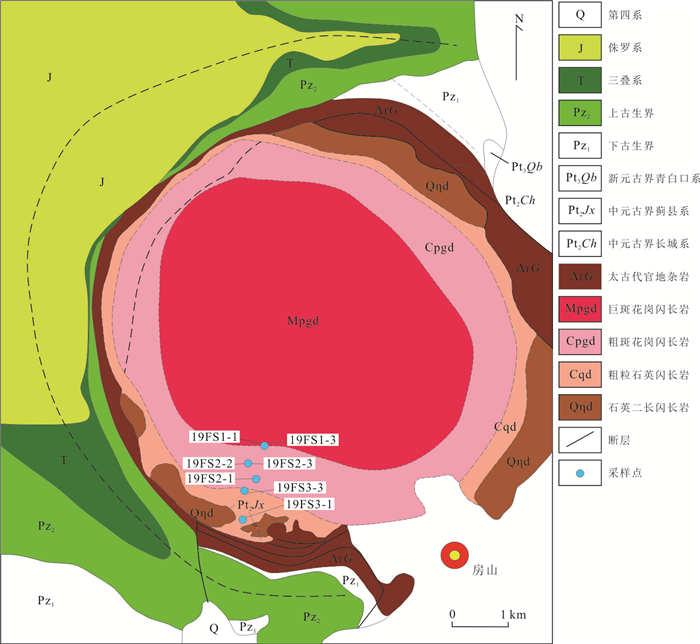
 下载:
下载:
